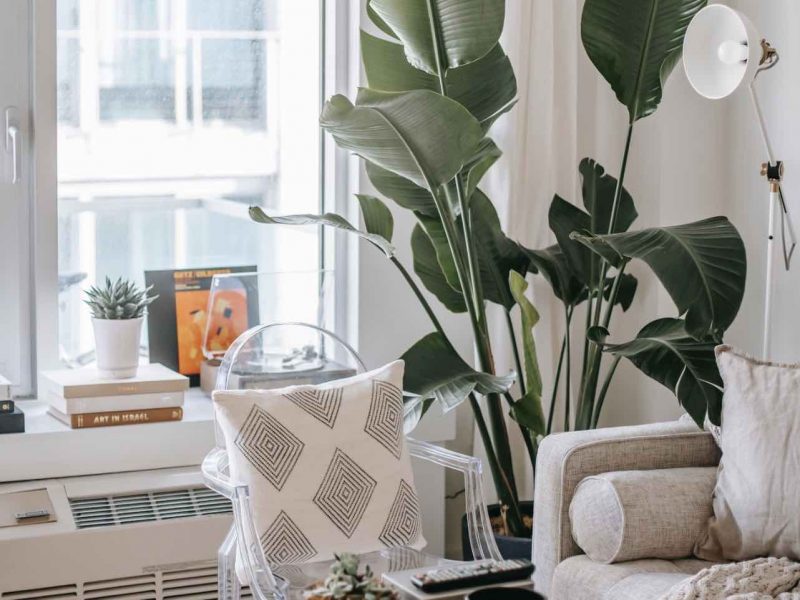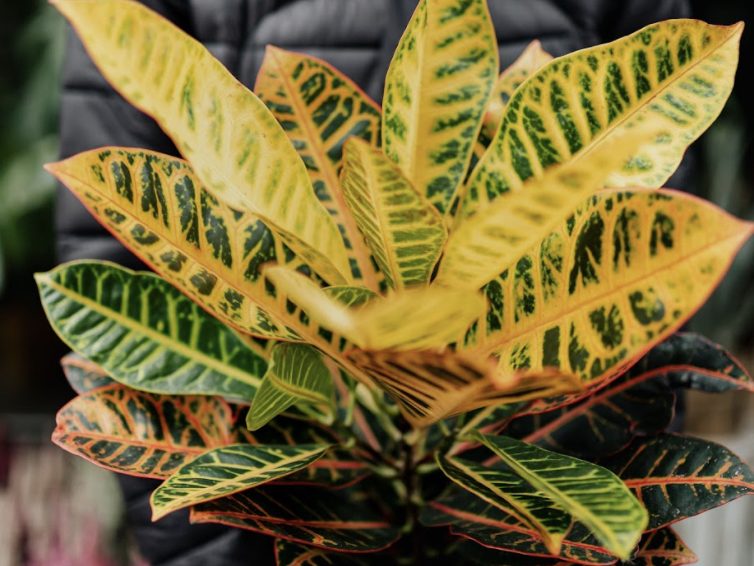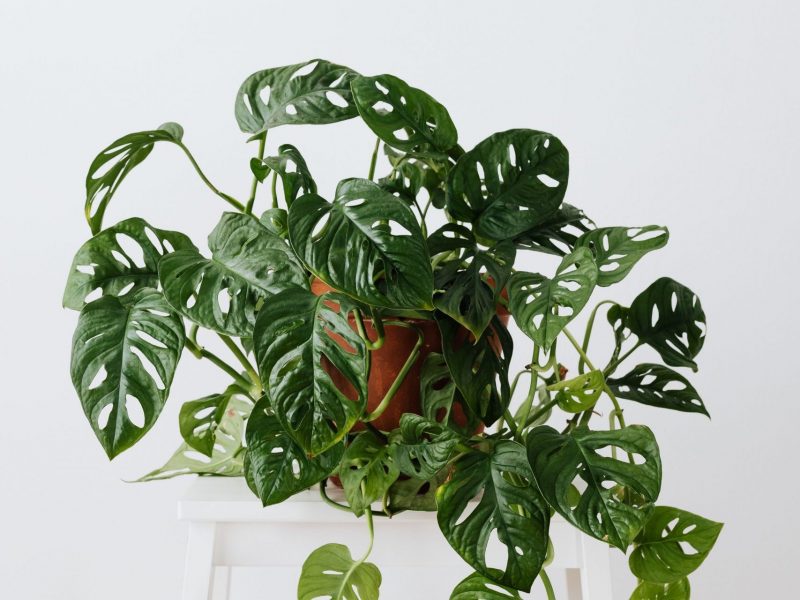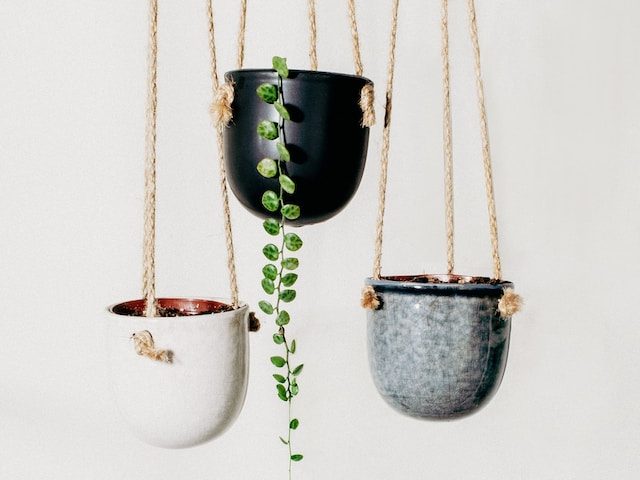
Top Houseplants for West-Facing Windows
It’s important to understand the difference in light that comes through each of your windows to help you decide where to place each of your plants. If you live in the northern hemisphere, west-facing windows are perfect for so many houseplants as they don’t have as much direct sunlight compared to south-facing windows, but still allow plenty of gorgeous afternoon sunshine to pour in.
We have curated a list of our favourite plants that will love being near a west-facing window. Some are easier to care for than others, some smaller or bushier than others so we hope you can find the perfect plant for you and your home.
*It’s important to note that this applies only to the northern hemisphere as it’s the other way around for the southern hemisphere.

African Mask Plant
Alocasia amazonica
If there is one plant that has risen up the popularity ranks recently, it’s the African Mask Plant! You can now buy these at basically every plant shop, market and superstore globally as they are definitely the most popular of the Alocasia family. And we totally understand why they have become so popular, their intense glossy shield-like leaves are adorned with strong white veins which really make them something special.
They aren’t a great plant for beginners, however, as they do require decent light levels (hence why they’re great for west-facing windows), as well as warm temperatures and a consistent high humidity level. Misting this plant is really crucial or it’ll start to develop some issues.
If in the right environment, your African Mask Plant can grow well above 1 metre but this will take many years as they don’t produce that many new leaves each year. This is why it’s crucial you take good care of the leaves your plant does have by regularly dusting and inspecting for issues.
Find out more in our African Mask Plant care guide.

Chinese Money Plant
Pilea Peperomioides
Otherwise known as the Chinese Money Plant (they are believed to bring good luck and fortune to its owner), Pilea plants are a must-have! They initially became popular because they are so easy to propagate which meant Pilea pups got passed around a lot between friends and family, earning itself the nickname ‘pass it on plant’
When it comes to care, Pilea’s are somewhere in-between fussy and low maintenance. They aren’t great in low light areas, and also hate soggy or super dry soil so finding the right balance is key for Pilea care. They’ll love the afternoon sunshine that will come through your west-facing window.
As your Pilea matures, the leaves can reach up to about 10cm in diameter which is incredible and makes all of the effort worth it!
Find out more in our Chinese Money Plant care guide.

Arrowhead Plant
Syngonium podophyllum
Native to the tropical rainforests of Central and South America, the Arrowhead great plant to have in your collection. When fully grown, they can reach nearly 2 meters tall with large leaves that can have a variety of colours and variegations.
As you can imagine, the Arrowhead likes warm and humid environments. Letting the soil dry out between waterings is a great way to mimic their natural habitats and making sure they have bright, but indirect light will stop the leaves from burning. This is why they are best suited to west-facing windows as the risks of leaf burn are lower.
With them being a little pickier over humidity and placement, we wouldn’t always recommend them for a starter houseplant. They’re also mildly toxic to pets, which doesn’t make them the most friendly for households with cats or dogs.
Find out more in our Arrowhead Plant care guide.

Satin Pothos
Epipremnum pictum Argyraeus
Known for their unique silver speckled leaves, the Satin Pothos is the perfect houseplant for every plant parent as they are super simple to care for. They can grow quite quickly in the right conditions and are very easy to propagate, so cuttings and young plants can make great gifts.
Bright, indirect light and a consistent watering schedule will keep them happy and thriving. West-facing windows are the best for a Satin Pothos as too much sunshine will burn the leaves. Avoiding colder rooms or areas with dryer air will also really help in making sure your Satin Pothos will stay healthy all year round.
Originating from southeast Asia these plants will also appreciate a little extra humidity, so spraying them with a mist bottle every now and then will keep them closer to their natural environment.
Find out more in our Satin Pothos care guide.

String of Hearts
Ceropegia woodii
Native to South Africa, the String of Hearts should be top on your list for trailing houseplants. You don’t get much more unique than their speckled heart-shaped leaves. The other thing we love about the String of Hearts is that it’s such a fast grower over the spring and summer months, you’ll blink and there will be two new leaves popping out somewhere.
The String of Hearts is a semi-succulent plant meaning they don’t need much water, otherwise, it’ll cause their delicate shallow leaves to rot pretty quickly. Oh, and because they have such shallow roots, you won’t need to repot for a very very long time.
It makes the perfect plant for hanging down shelving, and because its pet friendly, you don’t need to worry about it ever becoming too long!
Find out more in our String of Hearts care guide.

Croton Plant
Codiaeum variegatum
If you’re looking to bring a splash of colour into your home, then the Croton Plant is the perfect choice. Native to India and Indonesia, the unusual thing about Croton Plants is that they are genetically unstable which means every single plant will look slightly unique. Even when propagated, the new plants can look different to the mother plant.
There are so many types of Croton Plants showcasing red, yellow, pink, purple, orange and white leaves but luckily they all have the same care requirements. Like most other tropical plants, they need ample light, a moderate amount of water and a nice warm room to really thrive. It’s best to keep this one away from pets though as although it’s not the most toxic plant, it can cause some irritation when ingested.
Find out more in our Croton Plant care guide.

Elephant Ear
Colocasia
Known and loved for their larger than life, heart-shaped leaves, Elephant Ear Plants are the new popular houseplant on the block! Whilst they are most commonly grown outdoors, this doesn’t mean they can’t adapt nicely to your home. With enough light, a little boost to the humidity and good moisture in the soil, your Elephant Ear Plant could soon be boasting leaves that are nearly a meter in length!
It will require a little bit of work though to keep your Elephant Ear Plant thriving, from daily misting, to regularly dusting the leaves as the sheer size of them make them a dust magnet, it’s important to tend to an Elephant Ear Plant to keep it happy and healthy.
Find out more in our Elephant Ear care guide.

Fishbone Cactus
Epiphyllum anguliger
Their flat zig-zag leaves make the Fishbone Cactus something really special. And they aren’t even super difficult to care for which is a bonus. It’s important to note that the Fishbone Cactus is actually native to the jungles of Mexico rather than a desert. This means the care is slightly different to what you’d expect when you hear the word Cactus. They need a little bit more water and can only deal with some direct sunshine each day.
You’ll be pleased to hear that they are also really easy to propagate and are non-toxic too! The only downside is that they can be a little bit difficult to find but we hope as they continue to grow in popularity that they’ll soon be in every plant shop across the world.
Find out more in our Fishbone Cactus care guide.

Kentia Palm
Howea forsteriana
Kentia Palms are pretty hardy plants that can stand environments that many other houseplants wouldn’t be able to, making them quite easy to care for. They can grow up to 40 feet outdoors but will rarely get over 13 feet when kept indoors.
They can be quite fussy about watering, however, and prefer to get little and often as this stops their soil from drying out completely or being soggy for longer periods of time. They also aren’t great with having dusty leaves, so we recommend wiping them down with a damp cloth every now and then to keep them clean. Kentia Palms love the sunshine so west-facing windows are ideal for them!
The good news is that they are completely safe and non-toxic, so perfect for homes with pets or kids!
Find out more in our Kentia Palm care guide.

Monkey Mask Monstera
Monstera Adansonii
A close relative to the infamous Swiss Cheese Plant, the Monkey Mask Monstera never disappoints. With holes in the middle of the leaves, rather than running to the edges, this plant definitely stands out in a crowd. It can get a little rough and rugged looking as the vines intertwine around each other, but that gives it quite a rustic charm and brings a little bit of the jungle right to your home.
Monkey Mask Monstera plants can be grown with a moss pole if you’d prefer to prop it up, or it can be left to hang down out of the pot, making it adaptable to nearly any space in your home. When it comes to caring for your plant, avoid too much direct sunshine and make sure to mist the leaves regularly and your plant will be very happy! For placement next to a west-facing window, place it near but not next to the window and it’ll love it!
Find out more in our Monkey Mask Monstera care guide.

Raindrop Peperomia
Peperomia Polybotrya
Don’t mistake this one for the more common Pilea Peperomioides as it’s definitely got its own personality and is so much easier to care for!! With teardrop-shaped leaves, the Raindrop Peperomia only grows to about 30m high so is perfect for the windowsill of your west-facing window or small space.
When it comes to caring for them, they really aren’t fussy. Just a good amount of sunlight, moderate water levels and preferably away from cold drafts. One top tip we have to keep the leaves clean is misting them or wiping them down regularly as the large flat leaves just invite dust to settle. Oh, and they are safe for pets too so what’s not to love!
Find out more in our Raindrop Peperomia care guide.

Calathea Dottie
Calathea Roseopicta Dottie
With large glossy dark green (almost black) leaves, the Calathea Dottie is a plant for those who want to make a statement. Each leaf has a bright pink outline which you won’t see on any other plant! Native to South America, it’s important that Calathea Dottie plants are placed somewhere warm with a good level of humidity and bright but not direct sunlight. Without this environment, your plant will really struggle.
If you aren’t already sold on this plant just by looking at the incredible leaves, then we have a couple more reasons. Firstly, they purify the air in the room which helps us sleep a little better. They are also non-toxic so we don’t need to worry about putting them out of reach of pets or children which is great!
Calathea Dottie plants aren’t as common globally so you might need to take a look in more specialised plant shops and nurseries to find them.
Find out more in our Calathea Dottie care guide.














